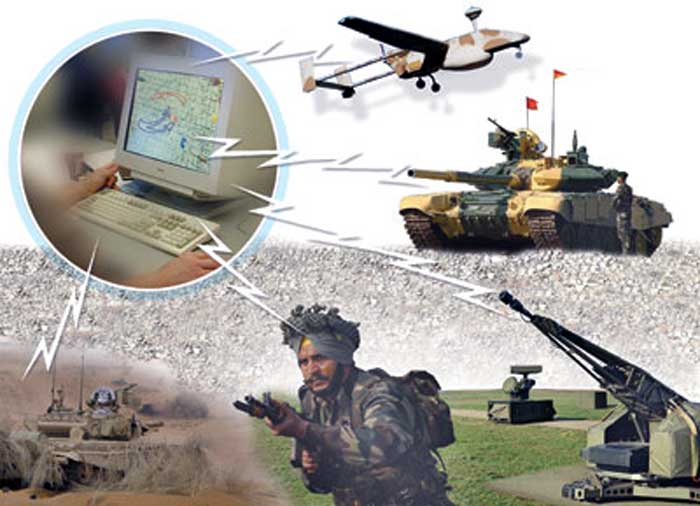
In 2004, Army’s Tactical Command, Control, Communications and Information (TAC C³I) system was taken up as part of Army’s quest for capacity building in netwok centric capabilities to fight modern day wars. Components of TAC C³I included the Battlefield Surveillance System (BSS), Battlefield Management System (BMS), Artillery Command, Control and Communications System (ACCS) and Air Defence Control and Reporting System (ADC&RS) all integrated through the Command Information and Decision Support System (CIDSS). TAC C³I is also to integrate Army’s Electronic Warfare System (EWS) and Electronic Intelligence (ELINT) System. The BMS unfortunately had to be foreclosed recently because of lack of budgetary support, although it was being pursued past 13 years. Closure of BMS has also deprived networking of Army’s ongoing F-INSAS (Future Infantry Soldier As a System) program, adversely affects the TAC C³I project and even networking capacity of Special Forces when operating deep behind enemy lines. Of all the components of the TAC C³I system, only the ACCCS has been fielded to-date, with balance inching forward. It would not be surprising if some of them meet the same fate as the BMS due to lack of budgetary support.
Prior to 2002, Defence Services were made to vacate 60+60 MHz of the spectrum without being allotted any alternate network to migrate their applications. In 2006, the Defence Forces projected for exclusive defence band, in line with international best practices and the need for larger bandwidth for network-centric warfare. However, with commercialization of mobile phones, the government wanted more spectrum to be vacated by the Defence Services. On May 22, 2009, the Ministry of Defence (MoD) inked a memorandum of understanding (MoU) with the Ministry of Communications and Information Technology (MoC&IT) for Defence Forces to vacate the spectrum amounting to 65 MHz (40 MHz in 2G band and 25 MHz in 3G band) in the 1700-2000 MHz sub band. In lieu of vacating the spectrum, MoC&IT agreed to: provide an exclusive and dedicated Optical Fibre Cable (OFC) Network to facilitate migration of existing defence systems – nationwide backbone communication infrastructure called ‘Project Network for Spectrum’ (NFS) for the three services (Army, Navy and Air Force); promulgation of an exclusive Defence Band (DB) and Defence Interest Zone (DIZ), and; waiver of spectrum charges for defence usage. NFS was approved by the government on July 3, 2012 at a cost of Rs 13,333 crore to be completed in 36 months.
NFS is to have four components: backbone of the core network; Army access network; Navy access network, and; Air Force network. The timelines for vacation of spectrum by Defence Services were linked with the implementation of Project NFS. Under the project, Bharat Sanchar Nigam Limited (BSNL) was to lay 60,000 km of OFC under the project covering 412 military stations, for which the OFC component has been divided into seven packages on a regional basis. Completion in 36 months meant that the project was to be completed by July 2015. Nothing was heard of the NFS till news reports appeared on May 17, 2018 stating that the government had raised the project cost to Rs 24,000 crore; increase of Rs 11,330 crore with original project cost being Rs 13,333 crore. This news report “quoting government sources”, said that the NFS project will be completed in 24 months, which by implication means by May 2020. However, on July 11, 2018, the Telecom Minister told Lok Sabha that the OFC network for Defence Services is likely to face overruns due to litigation in procurement and difficulties over optical cable contracts. He said, the network is to be completed in three and a half years and shall be implemented by BSNL. This takes the completion date of NFS to January 2022.
What can be said about a system where a defence-related project undertaken by state-owned telecommunications company (BSNL) to be completed by July 2015 is now projecting a completion date of January 2022. Not only the time delay but even the cost has almost doubled. Worse, there is no guarantee the completion date will not be prolonged further and costs will not escalate further. Unfortunately this has been the bane of India under all governments without exception, slogans like ‘minimum government, maximum governance’ notwithstanding. MoD’s role perhaps ended with signing the MoU, not that processing and execution of NFS would have been any better. A study undertaken by Headquarters Integrated Defence Staff (IDS) found that 144 schemes contracted between 2014 and 2017 took an average of 52 months to conclude, more than twice the stipulated 16 to 22-month period; to blame were ‘multiple and diffused structures with no single-point accountability, multiple decision-making heads, duplication of processes-avoidable redundant layers doing the same thing over and over again, delayed comments, delayed decision, delayed execution, no real-time monitoring, no program/project-based approach, tendency to fault-find rather than to facilitate’.
With the explosion of technology, ‘Digital India’, and some 650 million Indians using mobile phones including over 300 million with smart-phones according to technology consultancy ‘Counterpoint Research’, it should not be very difficult to gauge the drawbacks of optical transport backbone for Defence Services in providing seamless and real-time passage of information during offensive operations and mechanized manouevres in mobile warfare. Take the example of the NFS of Air Force Access Network presently running on BSNL hired bandwidth. News reports indicate that reliability of links on hired BSNL media are major concern, and that “Air Force has not been able to migrate their critical air defence communication components on non-radiating media”. How much of these problems will be resolved with launch of GSAT- 7A on December 19, 2018 meant for IAF’s strategic communications, only time will tell. Army’s TAC C³I system will take years to fully operationalize anyway, if at all.





Very valid article whose value will be realised only when we are outsmarted by technology. My only issue is the delays caused by MoD Finance and their accountability….. when will their heads roll?